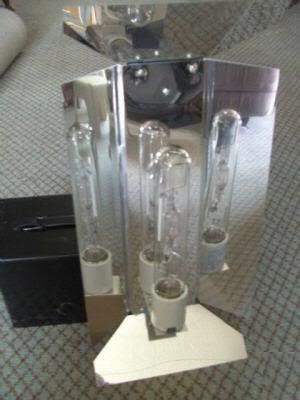EXAMPLE 1,050.1 g of chlorinated p-xylene, consisting of 47.61% of p-xylyl chloride, 43.76% of p-xylene, 3.6% of nuclear-chlorinated p-xylene and
5.03% of polychlorinated p-xylenes, the mixture containing exactly 500 g (3.55 moles) of p-xylyl chloride, are stirred with 546.7 g (3.9 moles) of
urotropin for 15 minutes, under nitrogen, in a 4 liter three-necked flask equipped with a reflux condenser and stirrer. 1,000 g of water are then
added and the mixture is refluxed for 3 hours. It is then allowed to cool, brought to a pH of 3-4 at room temperature with 170 ml of concentrated HCl,
and then refluxed for a further 15 minutes. Thereafter, the mixture is allowed to cool again and the aqueous phase is separated off. The organic
phase is distilled after addition of 0.01 g of hydroquinone.
|



 .
.


 Thankyou.
Thankyou.
 .
. .
Just kidding. I didn't alter the reaction that much. I put it on a water bath instead of 105 C because I would rather have a failed reaction
than a lost limb. As far as bleaching powder vs. purer hypochlorite goes, the reaction calls for calcium hypochlorite, not bleaching powder, its just
that in the early 1900's, when the patent was written bleaching powder was the main form of calcium hypochlorite available, the other 65% are
inert calcium salts that have no effect on the reaction. Is a beaker not glassware? Furthermore, my method is based on previous attempts by other
people. There is a good thread in the hive called benzyl chloride from hypochlorite salts in which a glass coffe pot, pool chlorinator tablets, and
paint can toluene are used on a water bath for around four hours without drying any of the ingredients. The reaction time is lengthened to compensate
for the lower temeprature. This is not that different from the way I did it. The importan tquestion still stands, what is the minimum temperature
which will prevent significant ring chlorination? I searched google and could find nothing useful.
.
Just kidding. I didn't alter the reaction that much. I put it on a water bath instead of 105 C because I would rather have a failed reaction
than a lost limb. As far as bleaching powder vs. purer hypochlorite goes, the reaction calls for calcium hypochlorite, not bleaching powder, its just
that in the early 1900's, when the patent was written bleaching powder was the main form of calcium hypochlorite available, the other 65% are
inert calcium salts that have no effect on the reaction. Is a beaker not glassware? Furthermore, my method is based on previous attempts by other
people. There is a good thread in the hive called benzyl chloride from hypochlorite salts in which a glass coffe pot, pool chlorinator tablets, and
paint can toluene are used on a water bath for around four hours without drying any of the ingredients. The reaction time is lengthened to compensate
for the lower temeprature. This is not that different from the way I did it. The importan tquestion still stands, what is the minimum temperature
which will prevent significant ring chlorination? I searched google and could find nothing useful. Thanks everyone for your
help, you especially Organikum.
Thanks everyone for your
help, you especially Organikum.
 .
.






 too easy why not just do it the old fashioned way. every time it works. never a
prob its the easiest one in the book.
too easy why not just do it the old fashioned way. every time it works. never a
prob its the easiest one in the book.









 I've distilled some out of the can
before, and its indeed 99%+ pure.
I've distilled some out of the can
before, and its indeed 99%+ pure.